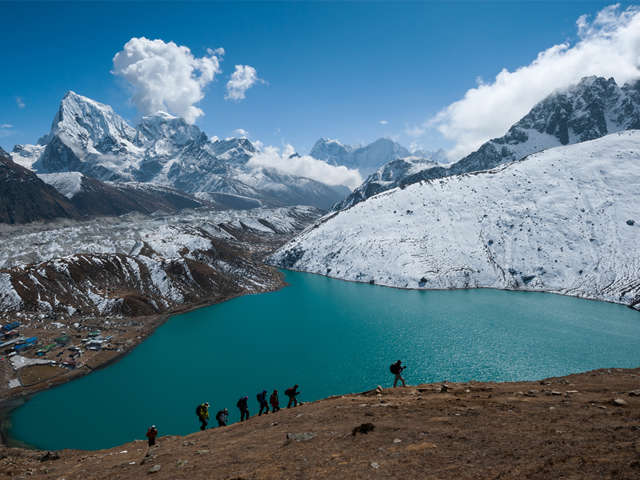
Are you considering trekking to Everest Base Camp? This trip is a journey of a lifetime for most people and can be both a challenging and memorable experience! Standing at the base of the Himalayas is breathtaking. You’ll see Everest soaring high above you against a vast, blue sky. At that moment, it will hit you—you’ve followed the footsteps of legends to one of the 7 natural world wonders.
The trek to Everest Base Camp is full of beauty and culture. You’ll wander through villages fluttering with prayer flags, explore the Nepalese culture, see the famous Khumbu Ice Fall, and finally stand at the base of the majestic Mount Everest.
Collectively, our local Everest Base Camp team has traveled to Everest Base Camp thousands of times. We’ve put together a list of tips for trekking to Everest Base Camp that will help you save time and money during the planning process and enjoy a smoother, more enjoyable trek.
34 Tips for Your Everest Base Camp Trek
Below, our Everest Base Camp adventure guides have pooled their tip tips, tricks, and travel hacks to help you plan and enjoy your trek to Everest Base Camp.
Tip 1: Budget Accordingly
Treks in the Everest Region are relatively affordable, especially when you consider most trips to this area last 14-21 days. This makes this grand adventure accessible even for the most prudent of budgeteers.
Your roundtrip airfare and trekking team will likely be your biggest expenses on the trip. Plan around $3000-$4250 per person. This includes:
- $1000-$1500 Roundtrip Airfare (learn how to save money on flights to Nepal in this article)
- $1400-$2000 Trekking team & all-inclusive trek accommodations (including guides, porters, fees & passes, flights between Kathmandu/Ramecchap and Lukla, tea house accommodations, and meals)
- $150-$200 Travel Insurance
- $200-$300 Cash for extra expenditures, food, & souvenirs
- $140-$200 Guide & porter tips

Tip 2: Know What to Expect from All-Inclusive Packages
Planning for all the moving pieces for a trek like Everest Base Camp can be tricky, especially when many of those accommodations may not have an easy way to communicate with ahead of time if you’re not local. Choosing an all-inclusive trekking company means everything is organized beforehand so you don’t have to wonder where you’ll sleep or worry about missing a flight.
All-Inclusive packages should include:
- Two nights of accommodation in Kathmandu (for before and after trek)
- Roundtrip airfare between Kathmandu/Ramecchap and Lukla where you will begin your trek
- Tea house accommodations during the trek
- Meals during your trek
- Airport transfers
- Everest trekking permit and TIMS (traveler security) card
- Guides & porters
- Local and government taxes
This package likely will not include:
- Accommodation for additional days you may choose to add unless agreed upon beforehand
- Last-minute helicopter transportation (this can be scheduled beforehand through your Everest Base Camp tour company—emergency helicopter transportation should be covered by your travel insurance)
- Snacks—trekking is exhausting so be sure to pack plenty!
- Tips for guides and porters—prepare for 10% of the cost of the trek
- Travel insurance
Tip 3: Choose a Reputable Trekking Company
Trekking with the right company can make or break your experience trekking to Everest Base Camp! Two of the biggest challenges with trekking in the Everest Region is the weather and the altitude. Weather can delay flights between Kathmandu/Ramecchap and Lukla for hours—or even days. Local Everest Base Camp trekking companies usually have very good relationships with the airports and can often handle these delays faster and more efficiently than single guides or individual trekkers can manage on their own.
Acclimatization is also very important on your trek, as you’ll be ascending to an altitude of 5,364m (17,598 ft). Some people are more sensitive to altitude than others, and there really is no training that can prepare you for that aspect of the journey (though we do recommend strength and aerobic training to help prepare for the physical exertion of the trek).
The best ways fend off altitude sickness are to have a good acclimatization schedule in place, catch symptoms early and adjust your trip accordingly, and to accommodate a fast descent if altitude sickness escalates. Experienced Everest Base Camp guides are well-trained and highly experienced in this area and in most cases can help the trekker make adjustments to overcome the symptoms and complete the trek—or help the trekker get down the mountain safely.

Tip 4: Choose a Trek Through Phortse
There are two primary routes to Everest Base Camp. The traditional or “Classic” route treks through Tengboche to Everest Base Camp. However, a little-known tip is to trek to Everest Base Camp through Phortse. This trek travels from Lukla to Phortse Thanga before reconnecting with the classic Everest Base Camp trail. The benefit of this route is that on your ascent you will skip many of the crowds often experienced between Namche and Tengboche. Instead, you’ll experience beautiful scenery that many trekkers do not have the chance to see.
Tengboche is best known for the Tengboche Monastery, which is why it is a popular route to Everest Base Camp. However, when you trek through Phortse, you will travel through Tengboche through your descent so you can still appreciate that memorable cultural experience.
Tip 5: Pick the Best Trekking Season
September to November is the most popular time to trek Everest Base Camp as the weather is best at this time. March to May is also a popular season as the weather is ideal and May is one of the warmest months of the year. This is also the time when Everest Base Camp climbers can see Everest Peak climbers at Base Camp. June to August is monsoon season which can make it very difficult to trek Everest Base Camp. December through February is cold, but it can be a great time to make the trek as the trails are virtually empty and the skies are generally sunny.
Tip 5: Train Ahead of Time
While trekking to Everest Base Camp doesn’t take the technical climbing skills required to ascent Everest itself, Everest Base Camp is strenuous and requires a good physical condition and endurance to complete—and enjoy—the trek.
We recommend doing several practice hikes, doing light strength training, and walking on an incline (treadmills work fine) while doing intervals on stairs (a stair-stepper machine works fine) until you’re comfortable walking at an incline for several hours at a time.
Tip 6: Break in Your Hiking Shoes
This tip for hiking Everest Base Camp probably goes without saying: Break in your hiking shoes beforehand. Starting your trek with chafed skin and blisters can seriously dampen your enjoyment during your journey. Make sure you break in your hiking shoes before you set foot on the Everest Base Camp trail. Blisters can be easy to prevent with the right preparation and equipment but can be difficult to heal and prevent discomfort with once they’ve formed—especially if you still have multiple days of trekking ahead of you.
Break in your hiking shoes by wearing them around the house or on errands for a week or two, then wear them on at least a couple hikes—the best breaking in happens off the pavement.

Tip 7: Prepare your Gear
The gear you use and wear the most is worth preparing and breaking in ahead of time. After all, an ill-fitting pack on the trail can make an otherwise wonderful trek gloomy! Choose a good, comfortable pair of hiking boots with ankle support. Make sure these do not pinch or chafe when you walk and be sure to break them in ahead of time (see tip above).
Also, choose a daypack that is comfortable to carry. Before leaving on your trek, practice carrying it on hikes with increasing increments of weight. You will also want to make sure you’ve worn your base layers before and that they don’t chafe or itch when you hike.
Some gear may be purchased in Kathmandu inexpensively. This area has a LOT of hiking gear shops, which helps keep prices low. We recommend purchasing items that require a great fit and breaking in ahead of time (such as thermals, base layers, and hiking boots). However, other gear and clothing can be purchased in Kathmandu for a great price!
Tip 8: Plan Extra Days at the End (Not Beginning)
If you’re planning to add any extra days to your trip, put them at the end of your trek—not at the beginning. The weather in the Himalayas often holds up flights from Lukla to Kathmandu. If your flight is delayed, having extra time as a buffer can help prevent missing your international flight back home.
Tip 9: Know Your Luggage Limits
When you book with an Everest Base Camp company, they’ll probably send you a packing list for Everest Base Camp as well as information about pack limits. The flight from Kathmandu to Lukla has strict weight regulations. Your main pack can only weigh 10kg (22 lbs) and your carry-on can only be 5kg (11lbs).
If you choose to trek with Adventure Hero, your main pack is the duffle bag we provide. This will be carried by your porters up the mountain. This will contain your sleeping bag, clothes, travel pillow or pillowcase, toiletries, and other supplies. Your carry-on will be your daypack, which will be packed with items you will need on the trail such as snacks, cameras, sunscreen, sunglasses, a headlamp, toilet paper, a water container, first aid/toiletry needs, etc. You can find a full packing list on our website.
Additional luggage not needed on your Everest Base Camp trek can be left at the hotel.
Tip 10: Prepare for Flight Delays
Although your professional Everest Base Camp Trekking Company will do their best to ensure your trip goes as smoothly as possible, the Himalayas have unpredictable weather that usually translates into flight delays for guests. In addition, Nepal is a developing country which often means communications between airports can be disorganized.
It is not uncommon for flights to be delayed for a few hours. In cases of extreme weather, this delay may be even longer. Prepare ahead of time for these delays. Schedule extra time between flights (see tip #8) and prepare with a book, snacks, and other comforts to make your wait less stressful.
Tip 11: Understand the Ramecchap Flight Diversion
While most flights to Lukla used to take off from Kathmandu, construction and flight volume at the Kathmandu airport has led to most flights being diverted to Ramecchap. You’ll know about this flight diversion ahead of time so your trekking company can prepare the 4-6-hour drive to and from the airport from Kathmandu.
Adventure Hero has a team member staying in Ramecchap to help make sure you get to your flights on time and to help arrange helicopter flights if preferred.
Tip 12: Enjoy Your Guides
One of the unique parts of traveling with a locally-based Everest Base Camp trekking company is getting to have a personalized view into the culture and customs of the Nepalese region. Your guide isn’t just there to show you the way up the mountain; they’re there to help make your trip more enjoyable and to provide you with information about the region and culture.
Tip 13: Purify Your Water
The water quality in Nepal isn’t the best, despite the glacial streams and lakes you’ll see. Bring a water filtration system and water purification tablets to avoid stomach bugs.
Tip 14: Ramp Up Your Health Habits
If you’re no stranger to traveling abroad, you probably already know to take extra precautions with washing your hands and avoiding tap water. On your Everest Base Camp trek, this is extra heightened since a stomach bug means having to trek several miles a day when you’re not feeling well.
Wash your hands and use hand sanitizer regularly. Make sure to purify your water with a water purification system or purification tablets.
Tip 15: Shower Early
Most water for showers on the trek will be heated by solar. This means you’ll have a better chance at hot water if you shower right when you reach the tea house instead of waiting until after dinner. Many people opt for using wet wipes on the trail instead of taking showers. This is because it can get quite cold in the tea houses, and damp hair can make you quite chilly!
Tip 16: Bring Cash
If you’re trekking Everest Base Camp with an all-inclusive tour company, you won’t have a lot of needs on your actual trek. However, there’s no denying that you may occasionally crave a stack of chips, a chocolate bar, or that you may have forgotten an essential toiletry item. There are shops in the villages along the trek, and you may even be able to find an ATM—but it is rarely in working order. Save yourself disappointment and hassle by bringing cash along for extra expenditures.
Tip 17: Stay Hydrated
This tip for hiking Everest Base Camp also probably goes without saying, but it’s important to stay hydrated on the trail. Even though you won’t be hiking in sweltering temperatures, hiking at this altitude and distance takes a toll on your body. Staying hydrated helps you keep your energy up while helping stave off altitude sickness. Often, when you’re not feeling well and aren’t in the “mood” to drink water, this is the time your body probably needs it the most.
If you don’t tend to be a water drinker, opt for tea or flavor your water with electrolyte tablets.
Tip 18: Bring a Thermos and Tea
This brings us to our next tip: Bring a travel thermos! While cool water is nice and hydrating, nothing beats some hot tea on the trek. It warms you up while also fulfilling the duty of providing hydration, which is essential for keeping yourself healthy and energized on the trail.
Tip 20: Set Bathroom Expectations
While the tea houses do a great job of offering a clean and comfortable place to stay while you’re trekking, the bathrooms in this remote and rugged area may surprise some visitors. Expect that the bathrooms likely won’t meet your standards of cleanliness, and plan to squat. These toilets often require manual flushing (pouring water from a bucket). You will also want to come prepared with toilet paper, hand sanitizer, and biodegradable wipes—some sinks are outside and very cold.
Tip 21: Bring Earplugs
You’ll be surprised by how comfortable the tea houses are and how well you sleep after a long day of trekking. However, the walls between rooms in the tea houses are quite thin and noise carries easily. If you’re a light sleeper, earplugs can help you get a good night’s sleep.
Tip 22: Avoid Ordering Meat on the Mountain
It’s wise to avoid eating meat on the mountain. The local culture forbids slaughtering animals in the area, which means any meat offered has been flown into Lukla then walked on the mountain, which means it’s unlikely the meat you eat will be fresh. Do yourself a favor on your trek and choose the vegetarian option whenever possible.
Tip 23: Bring Lots of Snacks
While all of your meals are included in an all-inclusive trek, you’ll have to carry your own snacks for the trail—and we recommend bringing plenty. Trekking is hard work! Give your body the fuel it needs by consuming calories along the trek. Combining protein and carbs is a great way to have a longer-lasting snack. Smart carbs like whole grains, fruits, or veggies will give you some fast energy while protein can provide you slower, more sustained fuel.
Tip 24: Bring a Treat
It can be tempting on a rigorous adventure trek to stick only with ultra-healthy snacks, but we’ve been on the Everest Base Camp trek enough times to predict that about halfway through we’re reallygoing to be craving a chocolate bar after a long day of hiking. The villages along the Everest Base Camp trek have a small selection of snacks for these cravings, but they can get expensive and may not be the same brand or quality you’re accustomed to. It can often be worth it to prepare ahead of time with some of your favorite treats.
Tip 25: Be Open With Your Guides About How You’re Feeling
It’s important to find a balance while trekking Everest Base Camp of pushing yourself during this exciting challenge and being cautious about afflictions like altitude sickness. Keep your guide apprised of how you’re doing during the trek. If you have a persistent headache, let your guide know. They can help determine what may help ease your symptoms and help watch for signs that it may signify altitude sickness.
Tip 26: Know Your Headaches
A headache can be one of the first signs of altitude problems when trekking Everest Base Camp. Small headaches are common and should not worry you or keep you from trekking. However, you should mention any headache to your guide so they can better keep tabs on your wellness. If your headache gets progressively worse or you have other signs of altitude sickness, it’s time to stop ascending or even head down. Altitude sickness, when caught quickly, can be reversed fairly easily but can become serious if allowed to progress. In many cases, Adventure Hero can arrange additional days on the mountain for acclimatization when needed. (Please see our Terms of Service).
Tip 27: Eat Enough at Each Meal
We provide three meals a day on the trek and a hot drink with each meal. If you’re especially hungry, order the Dal Bhatt as this is served all-you-can-eat. This is the traditional Nepali dish that consists of rice, dal, a vegetable, papad (fry bread), and pickle. Here is a good video showing the typical food and menu options: (View here).

Tip 28: Don’t Carry Too Much
It can be tempting to overprepare when you’re trekking up the mountain, but it will make your trek more enjoyable if you’re not carrying too much weight on your trek. We recommend only packing your essentials in your daypack and keeping the rest of your gear in your duffel bag to be carried by porters.
Your daypack should include your valuables, prescriptions, extra layers, rain gear, water, camera, snacks, and sunblock.
Tip 29: Use Sun Protection
Since you’re hiking in cold weather, many people don’t think about using sun protection. However, at those high altitudes, sun protection is especially important. Not only do you have less atmosphere protecting you from UV rays, but a sunburn would seriously dampen your enjoyment of your trek.
Make sure to have good sunscreen for exposed skin, sunglasses to protect against sun glare, and a brimmed hat to protect your eyes, face, and neck from sun rays.
Tip 30: Take Care With Batteries
While cellphones, cameras, or other rechargeable batteries can be charged at tea houses for a fee, this is often very expensive, usually between $5-10 USD/hour. Batteries drain faster at colder temperatures, so you can extend battery life by keeping batteries or other electronics close to your body. Many trekkers choose to put these devices in their sleeping bags while they sleep to keep them warm during the night.
Tip 31: Brush up on Your Card Games
Bring card games with you on the trek and brush up on the rules of your favorite games before you leave. You won’t have modern entertainment at tea houses such as laptops, television, or (reliable) internet, so prepare to entertain yourself the old-fashioned way.
You’ll meet trekkers from all over the world at tea houses, and a favorite way to pass time is to play card games together. This may become among your favorite memories along the trek.
Tip 32: Trek Slowly & Steadily
If you’re fit and active, your first comment to your trekking company or guides may be wondering about the number of miles you’re expected to trek each day. You’re probably used to be able to cover more distance—faster—than you’ll be scheduled to do on the Everest Base Camp trek. However, this pace is intentional to allow for important acclimatization. If you’ve never hiked at these altitudes before (and most people haven’t) then you have no idea how your body will respond to the acclimatization—and, unfortunately, physical health and endurance are not indicators for whether or not you’ll be affected by the altitude.
A slow and steady pace is the biggest factor in optimal acclimatization and the best way to maximize your chance for successfully completing the trek. So even if you prefer to hike more quickly at home, slow down and enjoy the views. Your body will thank you for it!
Tip 33: Add on Gokyo Lakes if You Have Time
If you can add a few extra days to your trek, you won’t regret adding on Gokyo Valley. The gorgeous lesser-traveled Gokyo landscape is nestled in a hidden valley of the Khumbu region. You’ll experience tranquil lakes traditional villages, and breathtaking landmarks such as the glistening ice trail of Cho La pass and the famed Kala Patthar black rock. Trekking Everest Base Camp & Gokyo Lakes only takes and three days longer than the traditional Everest Base Camp trek and is well worth the journey.
Tip 34: Bring a Camera
Hiking to Everest Base Camp is an accomplishment! While it seems obvious to bring a camera to document your success and to take photos of some of the stunning views, you’d be surprised how many people forget to pack a camera. Make sure you bring extra batteries and take care to keep them charged for the best moments of the trek (see tip #30 above).
How Can We Help?
Do you have any questions about trekking to Everest Base Camp and how to best prepare for your journey? Let us know! Reach out today to speak with one of our Adventure Specialists.


















